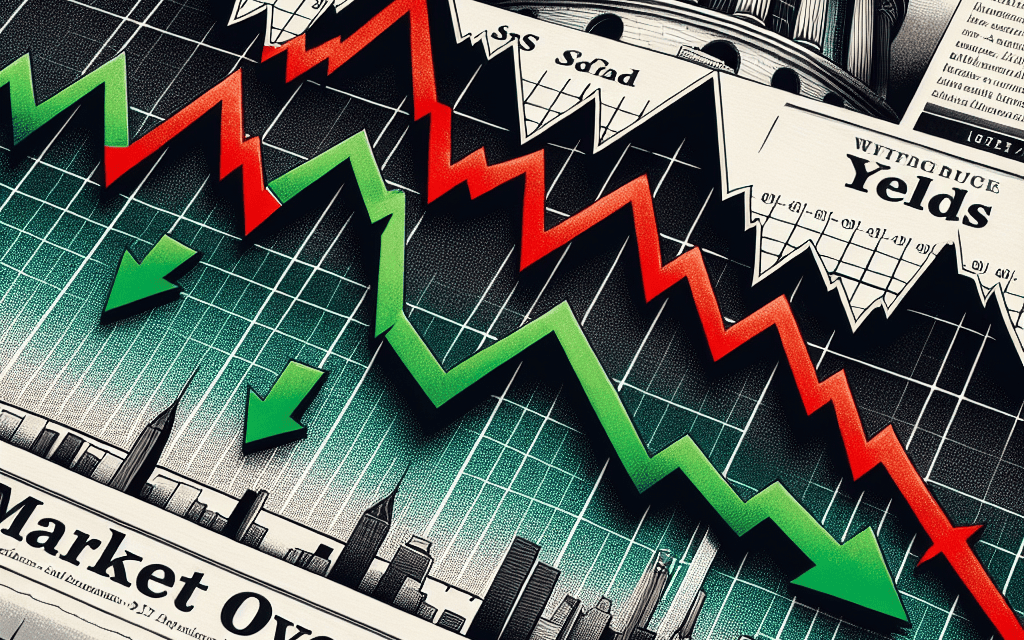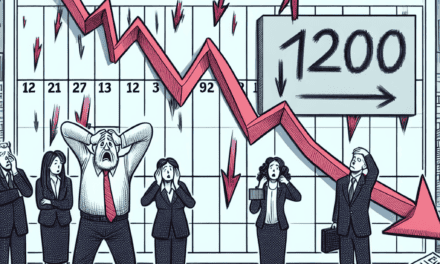“Rising Yields Cast Shadow: S&P 500 Faces Weekly Decline”
Introduction
The S&P 500 is poised for a weekly decline as rising bond yields exert pressure on equity markets, reflecting investor concerns over the potential impact of higher interest rates on economic growth and corporate profitability. This market overview examines the factors contributing to the S&P 500’s performance, including the influence of monetary policy expectations, inflationary pressures, and broader economic indicators. As yields on government bonds climb, investors are reassessing their risk appetite, leading to a shift in asset allocation that favors fixed-income securities over equities. This trend underscores the delicate balance between growth prospects and inflation risks that market participants must navigate in the current economic environment.
Impact Of Rising Yields On S&P 500 Performance
The S&P 500, a benchmark index representing the performance of 500 leading publicly traded companies in the United States, is poised for a weekly decline as rising yields exert pressure on equity markets. This development has captured the attention of investors and analysts alike, as the interplay between bond yields and stock market performance is a critical factor in financial decision-making. Understanding the impact of rising yields on the S&P 500 requires a closer examination of the underlying dynamics at play.
To begin with, bond yields, particularly those of U.S. Treasury securities, serve as a barometer for interest rates and economic expectations. When yields rise, it often signals that investors anticipate higher interest rates in the future, which can be attributed to factors such as inflationary pressures or a strengthening economy. In this context, rising yields can have a dual effect on the stock market. On one hand, they may reflect optimism about economic growth, which could be beneficial for corporate earnings. On the other hand, higher yields increase the cost of borrowing for companies and can lead to a re-evaluation of stock valuations, as future cash flows are discounted at a higher rate.
The recent uptick in yields has been driven by a combination of factors, including robust economic data and the Federal Reserve’s monetary policy stance. As the central bank signals its intention to maintain a tighter monetary policy to combat inflation, investors are adjusting their portfolios accordingly. This shift has led to a rotation out of equities, particularly those with high valuations, and into fixed-income securities, which now offer more attractive returns. Consequently, the S&P 500 has experienced downward pressure, as sectors sensitive to interest rate changes, such as technology and consumer discretionary, have borne the brunt of the sell-off.
Moreover, the impact of rising yields is not uniform across all sectors of the S&P 500. Financial stocks, for instance, tend to benefit from higher interest rates, as they can improve profit margins for banks and other financial institutions. Conversely, sectors with high levels of debt or those that rely heavily on future growth prospects may face headwinds. This divergence underscores the importance of sectoral analysis in understanding the broader market implications of yield movements.
In addition to sectoral shifts, investor sentiment plays a crucial role in shaping market dynamics. As yields rise, the risk-reward calculus for equities changes, prompting some investors to reassess their exposure to stocks. This reassessment can lead to increased volatility, as market participants react to new information and adjust their strategies. Furthermore, the global nature of financial markets means that developments in U.S. yields can have ripple effects across international markets, influencing capital flows and investment decisions worldwide.
In conclusion, the S&P 500’s anticipated weekly decline amid rising yields highlights the complex relationship between bond markets and equity performance. As investors navigate this challenging environment, they must consider a multitude of factors, including economic indicators, monetary policy, sectoral dynamics, and investor sentiment. By doing so, they can better position themselves to manage risk and capitalize on opportunities in an ever-evolving financial landscape. As the situation continues to unfold, market participants will remain vigilant, closely monitoring yield movements and their implications for the broader economy and stock market performance.
Historical Trends: S&P 500 Reactions To Yield Fluctuations
The S&P 500, a benchmark index that represents the performance of 500 leading publicly traded companies in the United States, is poised for a weekly decline as rising yields exert pressure on equity markets. Historically, fluctuations in bond yields have had a significant impact on the S&P 500, often dictating investor sentiment and influencing market dynamics. Understanding the historical trends of the S&P 500’s reactions to yield fluctuations provides valuable insights into the current market environment.
To begin with, bond yields, particularly those of U.S. Treasury securities, are closely watched by investors as they serve as a barometer for interest rates and economic conditions. When yields rise, it often signals expectations of higher interest rates, which can increase borrowing costs for companies and consumers alike. Consequently, higher yields can lead to a re-evaluation of equity valuations, as the present value of future cash flows is discounted at a higher rate. This dynamic tends to weigh on stock prices, particularly for growth-oriented companies that rely heavily on future earnings.
Historically, the relationship between the S&P 500 and bond yields has been complex, with various factors influencing the degree of impact. For instance, during periods of economic expansion, rising yields may reflect robust economic growth and increased inflation expectations. In such scenarios, the S&P 500 may initially react negatively to higher yields, but as economic growth translates into stronger corporate earnings, the index often recovers and continues its upward trajectory. Conversely, during times of economic uncertainty or recession, rising yields can exacerbate market volatility and lead to sustained declines in the S&P 500.
Moreover, the Federal Reserve’s monetary policy plays a crucial role in shaping the interplay between yields and the S&P 500. When the Fed signals a tightening of monetary policy through interest rate hikes or tapering of asset purchases, yields typically rise in anticipation of reduced liquidity in the financial system. This can lead to a reallocation of capital from equities to fixed-income securities, further pressuring the S&P 500. However, if the Fed’s actions are perceived as a response to an overheating economy, the initial negative impact on equities may be offset by optimism about future growth prospects.
In addition to macroeconomic factors, sector-specific dynamics also influence the S&P 500’s response to yield fluctuations. For example, financial stocks often benefit from rising yields, as higher interest rates can improve net interest margins for banks. On the other hand, sectors such as utilities and real estate, which are sensitive to interest rate changes due to their capital-intensive nature, may face headwinds in a rising yield environment. Consequently, the overall impact on the S&P 500 depends on the relative performance of its constituent sectors.
In conclusion, the S&P 500’s historical reactions to yield fluctuations underscore the intricate relationship between bond markets and equity markets. While rising yields can pose challenges for the index, the broader economic context and sector-specific factors play a pivotal role in determining the ultimate outcome. As the S&P 500 faces a potential weekly decline amid rising yields, investors must carefully consider these historical trends and their implications for future market movements. By doing so, they can better navigate the complexities of the current financial landscape and make informed investment decisions.
Investor Strategies During S&P 500 Declines
As the S&P 500 faces a weekly decline, largely influenced by rising yields, investors are prompted to reassess their strategies in navigating this volatile market environment. The interplay between stock market performance and bond yields is a critical factor that investors must consider. When yields rise, borrowing costs increase, which can dampen corporate profits and, consequently, stock prices. This inverse relationship often leads to a reallocation of assets, as investors seek to optimize their portfolios in response to changing economic conditions.
In times of market decline, diversification remains a cornerstone strategy for investors. By spreading investments across various asset classes, sectors, and geographies, investors can mitigate risk and reduce the impact of a downturn in any single area. For instance, while equities may be under pressure, bonds or commodities might offer more stability or even growth opportunities. This balanced approach can help preserve capital and provide a buffer against market volatility.
Moreover, investors might consider focusing on sectors that are less sensitive to interest rate fluctuations. Defensive sectors such as consumer staples, healthcare, and utilities often exhibit resilience during periods of rising yields. These sectors provide essential goods and services that maintain demand regardless of economic cycles, offering a degree of protection against market downturns. Additionally, companies with strong balance sheets and consistent cash flow are better positioned to weather economic challenges, making them attractive options for risk-averse investors.
Another strategy involves the use of dollar-cost averaging, which entails investing a fixed amount of money at regular intervals, regardless of market conditions. This approach allows investors to purchase more shares when prices are low and fewer when prices are high, potentially lowering the average cost per share over time. By maintaining a disciplined investment schedule, investors can avoid the pitfalls of trying to time the market, which is notoriously difficult even for seasoned professionals.
Furthermore, during periods of market decline, it is crucial for investors to maintain a long-term perspective. Short-term volatility can be unsettling, but history has shown that markets tend to recover and grow over the long run. By focusing on long-term goals and maintaining a well-thought-out investment plan, investors can avoid making impulsive decisions driven by fear or uncertainty. This steadfast approach can help ensure that temporary market fluctuations do not derail their financial objectives.
In addition to these strategies, investors should remain informed about macroeconomic trends and policy changes that could impact the market. Understanding the broader economic landscape, including factors such as inflation, employment rates, and central bank policies, can provide valuable insights into potential market movements. Staying informed enables investors to make more educated decisions and adjust their strategies as needed to align with evolving market conditions.
In conclusion, while the S&P 500’s weekly decline amid rising yields presents challenges, it also offers opportunities for strategic investment. By employing diversification, focusing on resilient sectors, utilizing dollar-cost averaging, maintaining a long-term perspective, and staying informed, investors can navigate this complex environment with greater confidence. These strategies not only help mitigate risk but also position investors to capitalize on potential market recoveries, ultimately supporting their financial goals in the face of uncertainty.
Economic Indicators Influencing S&P 500 Movements

The S&P 500, a key benchmark for U.S. equities, is poised for a weekly decline as rising bond yields exert pressure on the stock market. This development underscores the intricate relationship between economic indicators and market movements, highlighting the sensitivity of equities to changes in interest rates. As investors navigate this complex landscape, understanding the underlying economic factors becomes crucial.
One of the primary drivers of the recent market volatility is the increase in U.S. Treasury yields. When bond yields rise, they often signal expectations of higher interest rates, which can lead to increased borrowing costs for companies. This, in turn, can dampen corporate profits and reduce the attractiveness of stocks compared to fixed-income investments. Consequently, as yields climb, investors may reassess their portfolios, leading to a sell-off in equities, including those within the S&P 500.
Moreover, the Federal Reserve’s monetary policy plays a pivotal role in shaping market expectations. The central bank’s stance on interest rates and its approach to managing inflation are closely monitored by investors. Recently, the Fed has signaled a more hawkish approach, suggesting that rate hikes may be on the horizon to combat rising inflation. This prospect has contributed to the upward pressure on bond yields, further influencing stock market dynamics.
In addition to monetary policy, inflationary pressures themselves are a significant concern for market participants. As inflation rates rise, the purchasing power of consumers diminishes, potentially leading to reduced consumer spending. For companies within the S&P 500, which rely heavily on consumer demand, this can translate into lower revenue growth and profit margins. Therefore, inflation trends are a critical economic indicator that investors must consider when evaluating the market’s trajectory.
Furthermore, global economic conditions also impact the S&P 500’s performance. For instance, geopolitical tensions, trade policies, and economic growth rates in other major economies can have ripple effects on U.S. markets. In recent months, uncertainties surrounding international trade agreements and geopolitical conflicts have added layers of complexity to the investment landscape. These factors can influence investor sentiment and contribute to market volatility, as seen in the current environment.
Despite these challenges, it is important to recognize that the S&P 500 is composed of a diverse array of companies across various sectors. This diversification can provide a buffer against economic headwinds, as different industries may respond differently to changes in economic indicators. For example, sectors such as technology and healthcare may exhibit resilience in the face of rising yields, while others like utilities and real estate may be more adversely affected.
In conclusion, the S&P 500’s recent decline amid rising yields highlights the intricate interplay between economic indicators and market movements. As investors grapple with the implications of higher interest rates, inflationary pressures, and global economic conditions, a comprehensive understanding of these factors is essential. By closely monitoring these indicators and their potential impact on corporate performance, investors can make more informed decisions in navigating the ever-evolving financial landscape. As the market continues to adapt to these challenges, the ability to anticipate and respond to economic shifts will remain a key determinant of investment success.
Sector Analysis: Which Industries Are Most Affected By Rising Yields?
The S&P 500 is poised for a weekly decline as rising yields continue to exert pressure on the stock market. This development has prompted investors to reassess their portfolios, particularly focusing on sectors most vulnerable to fluctuations in interest rates. As yields rise, the cost of borrowing increases, which can have a profound impact on various industries. Understanding which sectors are most affected by these changes is crucial for investors seeking to navigate the current market environment.
To begin with, the technology sector is often one of the most sensitive to rising yields. This is primarily because tech companies, especially those in the growth phase, rely heavily on borrowing to finance their expansion and innovation efforts. Higher interest rates can lead to increased borrowing costs, which in turn can squeeze profit margins. Additionally, the valuation of tech stocks is often based on future earnings potential. When yields rise, the present value of these future earnings decreases, making tech stocks less attractive to investors. Consequently, the technology sector tends to experience heightened volatility during periods of rising yields.
In contrast, the financial sector often benefits from an environment of increasing interest rates. Banks, for instance, can experience improved profit margins as the spread between the interest they pay on deposits and the interest they earn on loans widens. This can lead to enhanced earnings potential for financial institutions, making them more appealing to investors. However, it is important to note that while rising yields can be advantageous for banks, they can also lead to increased default risks if borrowers struggle to meet higher interest payments. Therefore, the overall impact on the financial sector can be mixed, depending on the broader economic context.
Moving on to the real estate sector, rising yields can pose significant challenges. Real estate investment trusts (REITs) and other property-related investments often rely on debt financing to acquire and develop properties. As interest rates climb, the cost of financing these projects increases, potentially leading to reduced profitability. Moreover, higher yields can make fixed-income investments more attractive compared to real estate, prompting a shift in investor preferences. This can result in downward pressure on real estate valuations and a potential slowdown in the sector’s growth.
The utilities sector, known for its stability and consistent dividends, can also be adversely affected by rising yields. Utilities are capital-intensive businesses that often carry substantial debt loads to finance infrastructure projects. As interest rates rise, the cost of servicing this debt increases, which can impact profitability. Furthermore, higher yields can make utility stocks less attractive compared to bonds, as investors seek better returns with lower risk. This shift in investor sentiment can lead to a decline in utility stock prices.
In summary, rising yields have a varied impact across different sectors of the economy. While technology and real estate may face headwinds due to increased borrowing costs and shifts in investor preferences, the financial sector could potentially benefit from improved profit margins. Utilities, on the other hand, may struggle with higher debt servicing costs and increased competition from fixed-income investments. As the S&P 500 faces a weekly decline amid these rising yields, investors must carefully consider the sector-specific implications to make informed decisions in this evolving market landscape.
Comparing S&P 500 Declines: Current Vs. Past Market Conditions
The S&P 500, a key barometer of the U.S. stock market’s health, is poised for a weekly decline as rising yields exert pressure on equities. This development prompts a comparison between the current market conditions and past instances of similar declines. Historically, the S&P 500 has experienced fluctuations driven by various economic factors, and understanding these can provide valuable insights into the present scenario.
In the current market environment, the increase in bond yields is a significant factor contributing to the S&P 500’s decline. Rising yields often lead to higher borrowing costs for companies, which can dampen corporate profits and, consequently, investor sentiment. This scenario is reminiscent of past periods when the S&P 500 faced downward pressure due to similar economic conditions. For instance, during the 2013 “Taper Tantrum,” the Federal Reserve’s indication of reducing its bond-buying program led to a spike in yields, causing a temporary dip in the stock market. However, the market eventually stabilized as investors adjusted to the new monetary policy landscape.
Comparing the current situation to past market conditions, it is essential to consider the broader economic context. In previous instances, such as the early 2000s and the 2008 financial crisis, declines in the S&P 500 were often accompanied by significant economic downturns. The dot-com bubble burst and the subprime mortgage crisis were pivotal events that led to prolonged market declines. In contrast, the present economic backdrop is characterized by a robust recovery from the COVID-19 pandemic, albeit with challenges such as inflationary pressures and geopolitical tensions.
Moreover, the role of monetary policy cannot be overlooked when comparing past and present market conditions. In the past, central banks have played a crucial role in stabilizing markets through interest rate adjustments and quantitative easing measures. Currently, the Federal Reserve’s stance on interest rates and its approach to managing inflation are closely watched by investors. The anticipation of rate hikes to curb inflation has contributed to the rise in yields, impacting the S&P 500. This situation mirrors past instances where monetary policy shifts influenced market dynamics.
Another aspect to consider is investor behavior and sentiment. In previous market declines, investor panic and herd mentality often exacerbated the downturns. However, the current market environment is marked by a more informed and resilient investor base, aided by technological advancements and access to real-time information. This has led to a more measured response to market fluctuations, although volatility remains a constant feature.
Furthermore, the composition of the S&P 500 itself has evolved over time, with technology and growth-oriented sectors playing a more prominent role today than in past decades. This shift in sectoral weightings can influence how the index responds to economic changes. For instance, technology stocks, which are sensitive to interest rate changes, have been particularly affected by the recent rise in yields, contributing to the index’s decline.
In conclusion, while the S&P 500 is set for a weekly decline amid rising yields, comparing current market conditions with past instances reveals both similarities and differences. The interplay of economic factors, monetary policy, investor behavior, and sectoral dynamics all contribute to the market’s trajectory. Understanding these elements can provide valuable insights for investors navigating the complexities of the current financial landscape.
Future Outlook: S&P 500 Recovery Prospects Amid Yield Increases
The S&P 500, a key benchmark for U.S. equities, is poised for a weekly decline as rising yields continue to exert pressure on the market. This development has prompted investors and analysts to reassess the future outlook for the index, particularly in light of the broader economic landscape. As yields climb, the cost of borrowing increases, which can dampen corporate profits and, consequently, investor sentiment. This dynamic is crucial in understanding the current market environment and the potential recovery prospects for the S&P 500.
To begin with, the relationship between bond yields and equity markets is a fundamental aspect of financial analysis. When yields rise, fixed-income investments become more attractive, often leading investors to reallocate their portfolios away from equities. This shift can result in downward pressure on stock prices, as seen in the recent performance of the S&P 500. Moreover, higher yields can signal expectations of tighter monetary policy, which may further challenge equity valuations. In this context, the Federal Reserve’s stance on interest rates becomes a critical factor influencing market dynamics.
In recent months, the Federal Reserve has indicated a commitment to managing inflation, which has been persistently above target levels. This has led to speculation about potential rate hikes, contributing to the upward trajectory of yields. As a result, investors are closely monitoring economic indicators such as employment data and consumer spending to gauge the likelihood of policy adjustments. The interplay between these factors will be pivotal in shaping the S&P 500’s recovery prospects.
Despite the current challenges, there are reasons for cautious optimism regarding the S&P 500’s future performance. Historically, equity markets have demonstrated resilience in the face of rising yields, particularly when economic growth remains robust. In such scenarios, corporate earnings can continue to grow, offsetting the negative impact of higher borrowing costs. Additionally, sectors that benefit from a strengthening economy, such as financials and industrials, may experience relative outperformance, providing support to the broader index.
Furthermore, the global economic environment plays a significant role in influencing U.S. equity markets. As international economies recover from the disruptions caused by the pandemic, increased demand for American goods and services could bolster corporate revenues. This, in turn, may enhance investor confidence and contribute to a more favorable outlook for the S&P 500. However, it is essential to remain vigilant regarding potential headwinds, such as geopolitical tensions and supply chain disruptions, which could pose risks to global growth.
In conclusion, while the S&P 500 is currently facing a challenging environment due to rising yields, the future outlook is not devoid of positive prospects. The interplay between monetary policy, economic growth, and corporate earnings will be crucial in determining the index’s recovery trajectory. Investors should remain attentive to developments in these areas, as they will provide valuable insights into the market’s direction. By maintaining a balanced perspective and considering both risks and opportunities, market participants can navigate the complexities of the current landscape and make informed decisions regarding their investment strategies.
Q&A
1. **What is causing the S&P 500 to decline this week?**
Rising bond yields are contributing to the decline in the S&P 500.
2. **How do rising yields affect the stock market?**
Rising yields can make bonds more attractive compared to stocks, leading investors to shift their investments from equities to fixed-income securities.
3. **Which sectors are most impacted by rising yields?**
Technology and growth sectors are typically most impacted as their valuations are more sensitive to interest rate changes.
4. **What is the current trend in bond yields?**
Bond yields are increasing, reflecting expectations of higher interest rates or inflation.
5. **How are investors reacting to the current market conditions?**
Investors are becoming more cautious, potentially reallocating portfolios to mitigate risk from rising yields.
6. **What external factors are influencing the market this week?**
Economic data releases, central bank policy signals, and geopolitical events may be influencing market sentiment.
7. **What is the outlook for the S&P 500 in the near term?**
The outlook remains uncertain, with potential volatility as markets adjust to changing interest rate expectations.
Conclusion
The S&P 500 is poised for a weekly decline as rising bond yields exert pressure on equity markets. Higher yields typically make bonds more attractive compared to stocks, leading to a shift in investor sentiment and capital allocation. This environment often results in increased volatility and cautious trading, as market participants reassess risk and return profiles. The decline in the S&P 500 reflects broader concerns about the impact of monetary policy adjustments and economic conditions on corporate earnings and growth prospects. As yields continue to rise, the market may experience further fluctuations, underscoring the importance of strategic portfolio management and diversification.





